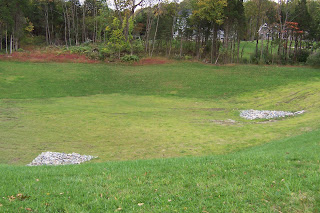To Lawn or Not to Lawn

If you are on the fence about whether to convert part or all of your lawn into a cottage-type garden, do give it a try. I was astonished to learn, at a talk by Leslie Jones Sauer (to see my earlier blog on forest restoration click here), that grass is nearly as impervious as asphalt! This is because of the nature of turf grass plants. That greensward effect is the result of lawn grass’s ability to quickly establish an underground net of interwoven roots. That’s what holds pieces of sod together.
That root system is only a few inches beneath the surface and, in a “good” lawn, so dense that very little rainwater penetrates beyond it. So, non-lawn gardens actually help the environment.
How do you decide how much, if any, of the lawn to keep? At our place, I’m very generous about what I consider to be the lawn. If it stays green after I cut it with the mower, it’s the lawn. We have about 8,000 square feet of it --- not quite 5% of our total property. About 90% of the landscape is wooded, with the remaining 5% given over to various types of things that fall into the category of gardening and active landscaping (flower beds, mulched seating areas, work areas, the garden house, etc.)
I found Julie Moir Messervy’s book The Inward Garden very helpful in deciding what should remain lawn and what should be something else. The basic question, of course, is how do you want to use your yard? Because we raise puppies for The Seeing Eye we have two Black Labs on hand most of the time – our own Emma and a puppy that needs to be heavily exercised. Being no spring chickens ourselves, we found that the most reliable means of ensuring the puppies’ exercise is Frisbee. Since the pups ultimately need to learn to retrieve, this also kills two birds with one stone. So, we need a lawn space that can accommodate two 50+ pound dogs running at high speed simultaneously; 8,000 square feet is barely enough. Folks who regularly host charitable fundraisers may need quite a bit more; folks with no kids or dogs may need far less.
We have three seating areas and a porch that each offer a different view. Even though the garden is quite informal, the underlying structure of it is not. The shape of the lawn is roughly a horizontal ellipse that has flower beds around the perimeter. A narrow bed anchored by mature trees divides the lawn into two nearly-equal parts: An open, active sun-filled one, where most of the daily action happens; and a passive one that is shady and inspires relaxation.
The garden edge is marked by a decorative twig fence and an arbor, as well as two mulched paths that lead through the back woods to the garden house. Those paths were established five decades ago when they were simply the easiest way for our family to walk through the woods to get “out back.” From the porch, they create natural viewing axes that we’ve emphasized with plantings and by adding garden doors in the deer fence. A combination of heavy shade and planned neglect creates an effect where the lawn grass fades imperceptibly into the leaf litter and mulch of the forest floor.
Growing and maintaining acres of lawn that you don’t actually use is a waste of time and energy that could be put to better use, such as growing ornamental and native plants.

